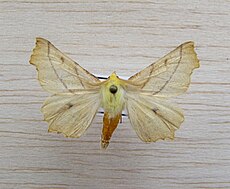Ennomos alniaria
| Canary-shouldered thorn | |
|---|---|

| |
| Scientific classification | |
| Domain: | Eukaryota |
| Kingdom: | Animalia |
| Phylum: | Arthropoda |
| Class: | Insecta |
| Order: | Lepidoptera |
| Family: | Geometridae |
| Genus: | Ennomos |
| Species: | E. alniaria
|
| Binomial name | |
| Ennomos alniaria | |
Ennomos alniaria, the canary-shouldered thorn, is a moth of the family Geometridae. The species was first described by Carl Linnaeus in his 1758 10th edition of Systema Naturae. It can be found in Europe in a wide variety of biotopes where there are deciduous trees, perhaps mostly in deciduous forests and gardens.


Description[edit]
The wingspan is 34–42 mm. The length of the forewings is 16–20 mm. Resembles Ennomos quercinaria, but has a canary-yellow thorax. The forewings are scalloped and there are also two cross lines. The wings are ochre yellow with greyish flecks. The bands, a small discal spot on the forewing and a larger discal spot on the hindwing are grey. The larva is brownish-grey, long and thin, with four raised cross-bands on the dorsal side. It closely resembles a dead twig.[1]
Other Ennomos species are similar.
Distribution[edit]
Caucasus and Russia to western Europe. The northern limit is Fennoscandia and the southern limit is the northern Mediterranean. It has also been introduced into British Columbia.[2]
Biology[edit]
The moths fly in one generation from July to October.[1] They are attracted to light.
The larvae feed on a number of deciduous trees including downy birch and silver birch, alder and goat willow.
References[edit]
- ^ Prout, L. B. (1912–16). Geometridae. In A. Seitz (ed.) The Macrolepidoptera of the World. The Palaearctic Geometridae, 4. 479 pp. Alfred Kernen, Stuttgart.pdf
- ^ Covell, Charles V. Jr.; Ferguson, Douglas C.; Straley, Gerald B. (May 1986). "Ennomos alniaria (Lepidoptera: Geometridae), a European moth recently discovered in British Columbia". The Canadian Entomologist. 118 (5). Cambridge, UK: Entomological Society of Canada: 449–501. doi:10.4039/Ent118499-5.

Notes[edit]
- ^ The flight season refers to the British Isles. This may vary in other parts of the range.
External links[edit]
- Canary-shouldered thorn on UKMoths
- Lepidoptera of Belgium Archived 2017-03-13 at the Wayback Machine
- Lepiforum e.V.
- De Vlinderstichting (in Dutch)
- BugGuide
